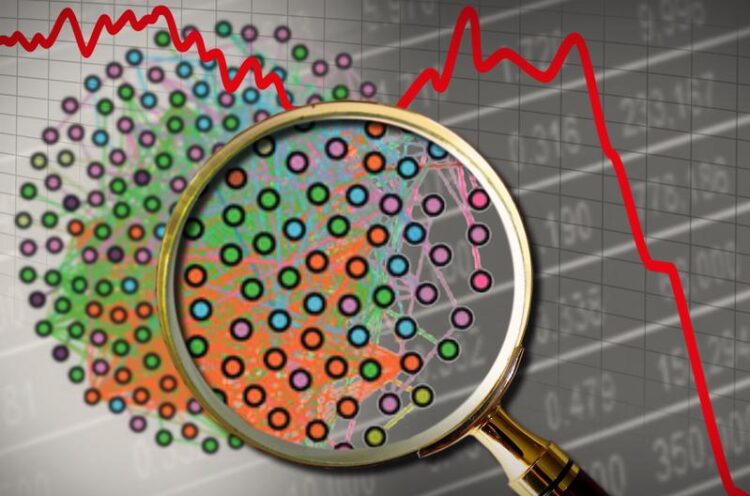Its curvature foreshadows the next financial bubble

Predicting the financial bubble
MPI for Mathematics in the Sciences
An international team of interdisciplinary researchers has identified mathematical metrics to characterize the fragility of financial markets. Their paper “Network geometry and market instability“ sheds light on the higher-order architecture of financial systems and allows analysts to identify systemic risks like market bubbles or crashes.
With the recent rush of small investors into so-called meme stocks and reemerging interest in cryptocurrencies talk of market instability, rising volatility, and bursting bubbles is surging. However, “traditional economic theories cannot foresee events like the US subprime mortgage collapse of 2007” according to study author Areejit Samal. He and his colleagues from more than ten mathematics, physics, economics, and complex systems focused institutions around the globe have made a great stride in characterizing stock market instability.
Distinguish between ‘business-as-usual’ periods and times of fragility
Their paper abstracts the complexity of the financial market into a network of stocks and employs geometry-inspired network measures to gauge market fragility and financial dynamics. They analyzed and contrasted the stock market networks for the USA S&P500 and the Japanese Nikkei-225 indices for a 32-year period (1985-2016) and for the first time were able to show that several discrete Ricci curvatures are excellent indicators of market instabilities. The work was recently published in the Royal Society Open Science journal and allows analysts to distinguish between ‘business-as-usual’ periods and times of fragility like bubbles or market crashes.
The network created by connecting stocks with highly correlated prices and trading volumes forms the structural basis of their work. The researchers then employ four discrete curvatures, developed by the director of Max Planck Institute for Mathematics in the Sciences Jürgen Jost and his coworkers, to study the changes in the structure of stock market networks over time. Their comparisons to other market stability metrics have shown that their four notions of curvature serve as generic indicators of market instability.
A better understanding of systemic risks
One curvature candidate, the Forman–Ricci curvature (FRE), has a particularly high correlation with traditional financial indicators and can accurately capture market fear (volatility) and fragility (risk). Their study confirms that in normal trading periods the market is very fragmented, whereas in times of bubbles and impending market crashes correlations between stocks become more uniform and highly interconnected. The FRE is sensitive to both sector-driven and global market fluctuations and whereas common indicators like the returns remain inconspicuous, network curvatures expose these dynamics and reach extreme values during a bubble. Thus, the FRE can capture the interdependencies within and between sectors that facilitate the spreading of perturbations and increase the danger of market crashes.
Max Planck Institute for Mathematics in the Sciences director Jürgen Jost summarizes the struggle of analyzing market fragility: “there are no easy definitions of a market crash or bubble and merely monitoring established market indices or log-returns does not suffice, but our methodology offers a powerful tool for continuously scanning market risk and thus the health of the financial system”. The insights gained by this study can help decision-makers to better understand systemic risk and identify tipping points, which can potentially forecast coming financial crises or possibly even avoid them altogether.
Royal Society Open Science is a peer-reviewed open access scientific journal published by the Royal Society since 2014. It focuses on publishing high-quality original research across the entire range of science and mathematics.
Wissenschaftliche Ansprechpartner:
Dr Areejit Samal
Mail: asamal@imsc.res.in
Institute of Mathematical Sciences (IMSc), Chennai, India and Head of a Max Planck Partner Group in collaboration with the Max Planck Institute forMathematics in the Sciences, Leipzig, Germany
Originalpublikation:
Samal A, Pharasi HK, Ramaia SJ, Kannan H, Saucan E, Jost J, Chakraborti A.:
Network geometry and market instability.
R. Soc. Open Sci. 8: 201734.
https://doi.org/10.1098/rsos.201734
Media Contact
All latest news from the category: Interdisciplinary Research
News and developments from the field of interdisciplinary research.
Among other topics, you can find stimulating reports and articles related to microsystems, emotions research, futures research and stratospheric research.
Newest articles

Security vulnerability in browser interface
… allows computer access via graphics card. Researchers at Graz University of Technology were successful with three different side-channel attacks on graphics cards via the WebGPU browser interface. The attacks…

A closer look at mechanochemistry
Ferdi Schüth and his team at the Max Planck Institut für Kohlenforschung in Mülheim/Germany have been studying the phenomena of mechanochemistry for several years. But what actually happens at the…

Severe Vulnerabilities Discovered in Software to Protect Internet Routing
A research team from the National Research Center for Applied Cybersecurity ATHENE led by Prof. Dr. Haya Schulmann has uncovered 18 vulnerabilities in crucial software components of Resource Public Key…





















